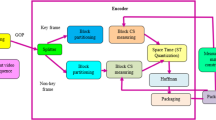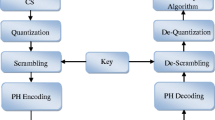Abstract
Non-iterative compressed sensing (CS) based recovery algorithms have been proposed in the recent years that efficiently recover the input from CS measurements without iterations. When it comes to reconstruction of images and videos for medical, military and surveillance applications, faster computations accompanied by least complexity and high accuracy is mandatory. Such large volumes of data can be effectively handled by non-iterative pseudo inverse based recovery algorithm (NIPIRA). This study uses NIPIRA to reconstruct the surveillance videos from the CS measurements and the algorithm’s efficiency is measured in terms of subjective measure and hardware implementation. The average peak signal to noise ratio exhibited by NIPIRA is around 32 dB; the mean opinion score is 3.5 that corresponds to ‘Fair’ quality reconstruction. Hardware implementation proves that NIPIRA recovers videos within seconds compared to iterative ones that take hours for the same. The upshot is that NIPIRA is perfectly suitable for surveillance applications.








Similar content being viewed by others
Explore related subjects
Discover the latest articles, news and stories from top researchers in related subjects.References
Blumensath, T., & Davies, M. E. (2009). Iterative hard thresholding for compressed sensing. Applied and Computational Harmonic Analysis, 27(3), 265–274.
Candès, E. J. (2008). The restricted isometry property and its implications for compressed sensing. Comptes Rendus Mathematique, 346(9), 589–592.
Candes, E., Romberg, J., & Tao, T. (2006). Robust uncertainty principles: Exact signal reconstruction from highly incomplete frequency information. IEEE Transactions on Information Theory, 52(2), 489–509.
Centre for Development of Advanced Computing (CDAC), Bangalore, India.
Dana, M. (2009). Compressed sensing makes every pixel count. What’s Happening in Mathematical Sciences, 7, 114–127.
Davies, R., Mihaylova, L., Pavlidis, N., & Eckley, I. (2013). ‘The effect of recovery algorithms on compressive sensing background subtraction’, Workshop on sensor data fusion: Trends solutions: Applications (SDF) (pp. 1–6).
Donoho, D. L., Tsaig, Y., Drori, I., & Starck, J. (2012). Sparse solution of underdetermined systems of linear equations by stagewise orthogonal matching pursuit. IEEE Transactions on Information Theory, 58(2), 1094–1121.
Florence Gnana Poovathy, J., & Radha, S. (2015). Reconstruction of compressively sensed color images using modified reduced runtime recovery algorithm. In IEEE international conference on wireless communications signal processing and networking (WISPNET 2016) (pp. 2426–2431).
Florence Gnana Poovathy, J., & Radha, S. (2016). Reconstruction of surveillance videos by non-iterative pseudo inverse based recovery algorithm (NIPIRA): A subjective experience. In International conference on advances in computing, communications and informatics (ICACCI), Jaipur, India (pp. 687–692).
Florence Gnana Poovathy J., Radha S. (2017) Non-iterative pseudo inverse based recovery algorithm (NIPIRA) for compressively sensed images and videos. Wireless Personal Communications 95(4): 4947–4966
Florence Gnana Poovathy, J., & Radha, S. (2015). Non-iterative threshold based recovery algorithm for compressively sensed images and videos. KSII Transactions on Internet and Information Systems, 9(10), 4160–4176.
Florence Gnana Poovathy, J., & Radha, S. (2017). Efficient reconstruction of compressively sensed images and videos using non-iterative method. International Journal of Electronics and Communications, 73, 89–97.
Hans, C. (2009). Bayesian lasso regression. Biometrika, 96(4), 835–845.
Leisti, T., Radun, J., Virtanen, T., Halonen, R., & Nyman, G. (2009). Subjective experience of image quality: Attributes, definitions, and decision making of subjective image quality. IS&T/SPIE electronic imaging (pp. 72420D–72420D).
Mrak, M., Grgic, S., & Grgic, M. (2003). Picture quality measures in image compression systems, EUROCON 2003. Computer as a tool. The IEEE Region, 8(1), 233–236.
Seshadrinathan, K., Soundararajan, R., Bovik, A. C., & Cormack, L. K. (2010). Study of subjective and objective quality assessment of video. IEEE transactions on Image Processing, 19(6), 1427–1441.
USC-Viterbi, School of Engineering-Image database. http://sipi.usc.edu/database/database.php?volume=misc. Accessed 27 November 2015.
Video database. http://see.xidian.edu.cn/vipsl/database-Video.html. Accessed 27 November 2015.
Zhang, Z. (2012). Comparison of sparse signal recovery algorithms with highly coherent dictionary matrices: The advantage of T-MSBL. Research Note.
Zhao, C., Ma, S., Zhang, J., Xiong, R., & Gao, W. (2017). Video compressive sensing reconstruction via reweighted residual sparsity. IEEE Transactions on Circuits and Systems for Video Technology, 27(6), 1182–1195.
Author information
Authors and Affiliations
Corresponding author
Appendix
Appendix
Apart from the experimental results, NIPIRA exhibits less error. This is because the sparse augmented matrix introduced in order to capture the measurements avoids the presence of spurious data and selects only the necessary information. Hence the optimum error cause by the logarithm is less than the additive or combined error. This is mathematically proved by the following derivation.
Optimality of NIPIRA This subsection mathematically supports the algorithmic procedure of NIPIRA with the proof for optimality of the algorithm. To prove the same, it is necessary to prove that the error between the input and reconstructed vectors \(\Vert x-\varPhi ^{\dagger } y\Vert _{2}\) is dependent on the difference terms \(\Vert x-x_{s}\Vert _{2}\), \(\dfrac{\Vert x-x_{s}\Vert _{1}}{\sqrt{s}}\) and \(\Vert e\Vert _{2}\) (Florence Gnana Poovathy and Radha 2016). The estimate that would reconstruct the best approximation is denoted as \(\varPhi ^{\dagger } y\), where \(\dagger \) signifies the pseudo inverse. \(\Vert x-\varPhi ^{\dagger } y\Vert _{2}\) can be represented in terms of \(\Vert x-x_{s}\Vert _{2}\) and \(\Vert e\Vert _{2}\) as follows:
This can be combined as,
For general CS recovery process, a common lemma (Candes et al. 2006) is available which states that
Therefore,
and
Substituting Eqs. 8 and 9 in 6,
Combining the like terms together,
From Eq. 11, it is proved that, the optimum error exhibited by NIPIRA is less than the combined error term \(\Vert x-x_{s}\Vert _{2}\) and \(\Vert e\Vert _{2}\). Hence optimality in reconstruction is preserved perfectly by NIPIRA. Another important parameter that can define the perfection of an algorithm is accuracy. Taking surveillance videos as input, the accuracy in recovery is above 95%. This projects NIPIRA to be the best non-iterative algorithm for reconstruction of surveillance videos. The PSNR obtained using NIPIRA is averagely 30 dB for 31.25% of input information (i.e. \(M=20\)).
Rights and permissions
About this article
Cite this article
Florence Gnana Poovathy, J., Radha, S. & Suganesh, V. Non-iterative CS recovery algorithm for surveillance applications: subjective and real-time experience. Multidim Syst Sign Process 30, 921–941 (2019). https://doi.org/10.1007/s11045-018-0584-2
Received:
Revised:
Accepted:
Published:
Issue Date:
DOI: https://doi.org/10.1007/s11045-018-0584-2




